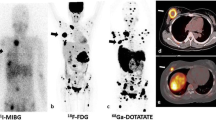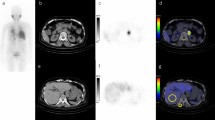Abstract
Purpose
The purpose of the present study was to evaluate the diagnostic accuracy of 68Ga-DOTANOC positron emission tomography (PET)/CT in patients with suspicion of pheochromocytoma.
Methods
Data of 62 patients [age 34.3 ± 16.1 years, 14 with multiple endocrine neoplasia type 2 (MEN2)] with clinical/biochemical suspicion of pheochromocytoma and suspicious adrenal lesion on contrast CT (n = 70), who had undergone 68Ga-DOTANOC PET/CT, were retrospectively analyzed. PET/CT images were analyzed visually as well as semiquantitatively, with measurement of maximum standardized uptake value (SUVmax), SUVmean, SUVmax/SUVliver, and SUVmean/SUVliver. Results of PET/CT were compared with 131I-metaiodobenzylguanidine (MIBG) imaging, which was available in 40 patients (45 lesions). Histopathology and/or imaging/clinical/biochemical follow-up (minimum 6 months) was used as reference standard.
Results
The sensitivity, specificity, and accuracy of 68Ga-DOTANOC PET/CT was 90.4, 85, and 88.7 %, respectively, on patient-based analysis and 92, 85, and 90 %, respectively, on lesion-based analysis. 68Ga-DOTANOC PET/CT showed 100 % accuracy in patients with MEN2 syndrome and malignant pheochromocytoma. On direct comparison, lesion-based accuracy of 68Ga-DOTANOC PET/CT for pheochromocytoma was significantly higher than 131I-MIBG imaging (91.1 vs 66.6 %, p = 0.035). SUVmax was higher for pheochromocytomas than other adrenal lesions (p = 0.005), MEN2-associated vs sporadic pheochromocytoma (p = 0.012), but no difference was seen between benign vs malignant pheochromocytoma (p = 0.269).
Conclusion
68Ga-DOTANOC PET/CT shows high diagnostic accuracy in patients with suspicion of pheochromocytoma and is superior to 131I-MIBG imaging for this purpose. Best results of 68Ga-DOTANOC PET/CT are seen in patients with MEN2-associated and malignant pheochromocytoma.





Similar content being viewed by others
References
Werbel SS, Ober KP. Pheochromocytoma. Update on diagnosis, localization, and management. Med Clin North Am 1995;79:131–53.
Manger WM, Gifford RW. Pheochromocytoma: a clinical overview. In: Laragh JH, Brenner BM, editors. Hypertension: pathophysiology, diagnosis and management. New York: Raven; 1995. p. 225–44.
Neumann HPH, Berger DP, Sigmund G, Blum U, Schmidt D, Parmer RJ, et al. Pheochromocytomas, multiple endocrine neoplasia type 2, and von Hippel-Lindau disease. N Engl J Med 1993;329:1531–8.
Lenders JW, Pacak K, Walther MM, Linehan WM, Mannelli M, Friberg P, et al. Biochemical diagnosis of pheochromocytoma: which test is best? JAMA 2002;287:1427–34.
Quint LE, Glazer GM, Francis IR, Shapiro B, Chenevert TL. Pheochromocytoma and paraganglioma: comparison of MR imaging with CT and I-131 MIBG scintigraphy. Radiology 1987;165:89–93.
Bombardieri E, Giammarile F, Aktolun C, Baum RP, Bischof Delaloye A, Maffioli L, et al. 131I/123I-metaiodobenzylguanidine (mIBG) scintigraphy: procedure guidelines for tumour imaging. Eur J Nucl Med Mol Imaging 2010;37:2436–46.
Feggi L, Degli Uberti E, Pansini GC, Transforini G, Prandini N, Ambrosio MR, et al. Pitfalls in scintigraphic detection of neuroendocrine tumours. Eur J Nucl Med 1992;19:214–8.
Sharma P, Dhull VS, Jeph S, Reddy RM, Singh H, Naswa N, et al. Can hybrid SPECT-CT overcome the limitations associated with poor imaging properties of 131I-MIBG?: comparison with planar scintigraphy and SPECT in pheochromocytoma. Clin Nucl Med 2013;38:e346–53.
Timmers HJ, Chen CC, Carrasquillo JA, Whatley M, Ling A, Eisenhofer G, et al. Staging and functional characterization of pheochromocytoma and paraganglioma by 18F-fluorodeoxyglucose (18F-FDG) positron emission tomography. J Natl Cancer Inst 2012;104:700–8.
Fiebrich HB, Brouwers AH, Kerstens MN, Pijl ME, Kema IP, de Jong JR, et al. 6-[F-18]Fluoro-L-dihydroxyphenylalanine positron emission tomography is superior to conventional imaging with (123)I-metaiodobenzylguanidine scintigraphy, computer tomography, and magnetic resonance imaging in localizing tumors causing catecholamine excess. J Clin Endocrinol Metab 2009;94:3922–30.
Ilias I, Yu J, Carrasquillo JA, Chen CC, Eisenhofer G, Whatley M, et al. Superiority of 6-[18F]-fluorodopamine positron emission tomography versus [131I]-metaiodobenzylguanidine scintigraphy in the localization of metastatic pheochromocytoma. J Clin Endocrinol Metab 2003;88:4083–7.
Trampal C, Engler H, Juhlin C, Bergström M, Långström B. Pheochromocytomas: detection with 11C hydroxyephedrine PET. Radiology 2004;230:423–8.
Naji M, AL-Nahhas A. 68Ga-labelled peptides in the management of neuroectodermal tumours. Eur J Nucl Med Mol Imaging 2012;39:S61–7.
Mundschenk J, Unger N, Schulz S, Höllt V, Schulz S, Steinke R, et al. Somatostatin receptor subtypes in human pheochromocytoma: subcellular expression pattern and functional relevance for octreotide scintigraphy. J Clin Endocrinol Metab 2003;88:5150–7.
Win Z, Al-Nahhas A, Towey D, Todd JF, Rubello D, Lewington V, et al. 68Ga-DOTATATE PET in neuroectodermal tumours: first experience. Nucl Med Commun 2007;28:359–63.
Naji M, Zhao C, Welsh SJ, Meades R, Win Z, Ferrarese A, et al. 68Ga-DOTA-TATE PET vs. 123I-MIBG in identifying malignant neural crest tumours. Mol Imaging Biol 2011;13:769–75.
Kroiss A, Putzer D, Uprimny C, Decristoforo C, Gabriel M, Santner W, et al. Functional imaging in phaeochromocytoma and neuroblastoma with 68Ga-DOTA-Tyr 3-octreotide positron emission tomography and 123I-metaiodobenzylguanidine. Eur J Nucl Med Mol Imaging 2011;38:865–73.
Naswa N, Sharma P, Nazar AH, Agarwal KK, Kumar R, Ammini AC, et al. Prospective evaluation of 68Ga-DOTA-NOC PET-CT in phaeochromocytoma and paraganglioma: preliminary results from a single centre study. Eur Radiol 2012;22:710–9.
Maurice JB, Troke R, Win Z, Ramachandran R, Al-Nahhas A, Naji M, et al. A comparison of the performance of 68Ga-DOTATATE PET/CT and 123I-MIBG SPECT in the diagnosis and follow-up of phaeochromocytoma and paraganglioma. Eur J Nucl Med Mol Imaging 2012;39:1266–70.
Zhernosekov KP, Filosofov DV, Baum RP, Aschoff P, Bihl H, Razbash AA, et al. Processing of generator-produced 68Ga for medical application. J Nucl Med 2007;48:1741–8.
van der Harst E, de Herder WW, Bruining HA, Bonjer HJ, de Krijger RR, Lamberts SW, et al. [(123)I]metaiodobenzylguanidine and [(111)In]octreotide uptake in benign and malignant pheochromocytomas. J Clin Endocrinol Metab 2001;86:685–93.
Hofland LJ, Lamberts SW, van Hagen PM, Reubi JC, Schaeffer J, Waaijers M, et al. Crucial role for somatostatin receptor subtype 2 in determining the uptake of [111In-DTPA-D-Phe1]octreotide in somatostatin receptor-positive organs. J Nucl Med 2003;44:1315–21.
Srirajaskanthan R, Kayani I, Quigley AM, Soh J, Caplin ME, Bomanji J. The role of 68Ga-DOTATATE PET in patients with neuroendocrine tumors and negative or equivocal findings on 111In-DTPA-octreotide scintigraphy. J Nucl Med 2010;51:875–82.
Wild D, Mäcke HR, Waser B, Reubi JC, Ginj M, Rasch H, et al. 68Ga-DOTANOC: a first compound for PET imaging with high affinity for somatostatin receptor subtypes 2 and 5. Eur J Nucl Med Mol Imaging 2005;32:724.
Wild D, Schmitt JS, Ginj M, Mäcke HR, Bernard BF, Krenning E, et al. DOTA-NOC, a high-affinity ligand of somatostatin receptor subtypes 2, 3 and 5 for labelling with various radiometals. Eur J Nucl Med Mol Imaging 2003;30:1338–47.
Pettinato C, Sarnelli A, Di Donna M, Civollani S, Nanni C, Montini G, et al. 68Ga-DOTANOC: biodistribution and dosimetry in patients affected by neuroendocrine tumors. Eur J Nucl Med Mol Imaging 2008;35:72–9.
Unger N, Serdiuk I, Sheu SY, Walz MK, Schulz S, Saeger W, et al. Immunohistochemical localization of somatostatin receptor subtypes in benign and malignant adrenal tumours. Clin Endocrinol (Oxf) 2008;68:850–7.
Naswa N, Sharma P, Suman Kc S, Lata S, Kumar R, Malhotra A, et al. Prospective evaluation of 68Ga-DOTA-NOC PET-CT in patients with recurrent medullary thyroid carcinoma: comparison with 18F-FDG PET-CT. Nucl Med Commun 2012;33:766–74.
Miederer M, Molatore S, Marinoni I, Perren A, Spitzweg C, Reder S, et al. Functional imaging of pheochromocytoma with Ga-DOTATOC and C-HED in a genetically defined rat model of multiple endocrine neoplasia. Int J Mol Imaging 2011;2011:175352.
Rodriguez JM, Balsalobre M, Ponce JL, Ríos A, Torregrosa NM, Tebar J, et al. Pheochromocytoma in MEN 2A syndrome. Study of 54 patients. World J Surg 2008;32:2520–6.
Furuta N, Kiyota H, Yoshigoe F, Hasegawa N, Ohishi Y. Diagnosis of pheochromocytoma using [123I]-compared with [131I]-metaiodobenzylguanidine scintigraphy. Int J Urol 1999;6:119–24.
Timmers HJ, Kozupa A, Eisenhofer G, Raygada M, Adams KT, Solis D, et al. Clinical presentations, biochemical phenotypes, and genotype-phenotype correlations in patients with succinate dehydrogenase subunit B-associated pheochromocytomas and paragangliomas. J Clin Endocrinol Metab 2007;92:779–86.
Havekes B, King K, Lai EW, Romijn JA, Corssmit EP, Pacak K. New imaging approaches to phaeochromocytomas and paragangliomas. Clin Endocrinol (Oxf) 2010;72:137–45.
Conflicts of interest
None.
Author information
Authors and Affiliations
Corresponding author
Rights and permissions
About this article
Cite this article
Sharma, P., Dhull, V.S., Arora, S. et al. Diagnostic accuracy of 68Ga-DOTANOC PET/CT imaging in pheochromocytoma. Eur J Nucl Med Mol Imaging 41, 494–504 (2014). https://doi.org/10.1007/s00259-013-2598-1
Received:
Accepted:
Published:
Issue Date:
DOI: https://doi.org/10.1007/s00259-013-2598-1




